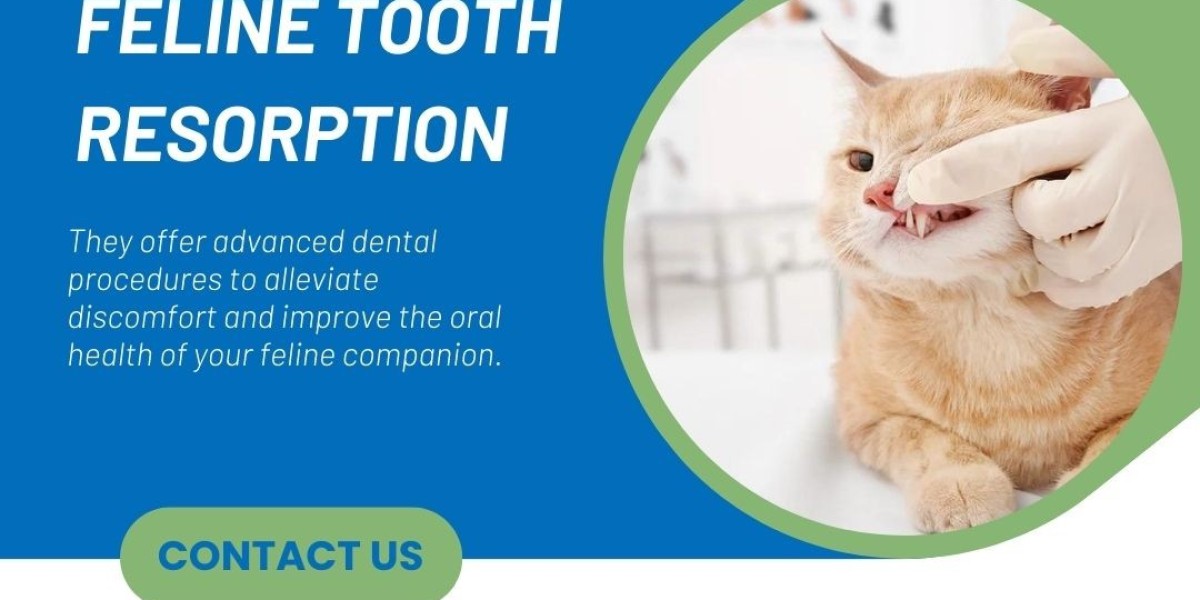Veterinary Dental Care specializes in treating Feline Tooth Resorption, providing relief for your beloved cat. Also known as feline odontoclastic resorptive lesions (FORLs), is often difficult to detect in its early stages, making regular veterinary dental care crucial for early diagnosis and treatment.
This process can be pretty painful for our feline companions, as the sensitive dentin and nerves within the tooth become exposed. Unfortunately, the exact cause of feline tooth resorption is still unknown, but researchers believe that a combination of genetic, immune system, and environmental factors may contribute to its development.
Signs and symptoms of feline tooth resorption
Recognizing the signs and symptoms of feline tooth resorption is essential for early intervention and management. As cat owners, it is our responsibility to closely monitor our furry friends for any changes in their behavior or oral health. Some common signs of a feline tooth include:
Drooling and oral discomfort: Cats with tooth resorption often experience pain and discomfort, leading to excessive drooling and difficulty eating or chewing their food.
Bad breath: Foul-smelling breath can be a sign of dental issues, including tooth resorption. The decay and breakdown of tooth structure can result in an unpleasant odor emanating from the mouth.
Bleeding or inflamed gums: If you notice redness, swelling, or bleeding along the gumline, it could be an indication of feline tooth resorption. These symptoms occur as the body tries to respond to the damaged tooth structure.
Causes of feline tooth resorption
While the exact causes of feline tooth resorption remain unclear, several factors have been identified as potential contributors to the development of this condition. Some of the possible causes include:
Genetic predisposition: Certain breeds, such as Siamese and Abyssinians, have shown a higher susceptibility to tooth resorption. This suggests a potential genetic component that predisposes these cats to develop this dental condition.
Immune system dysfunction: An abnormal immune response may play a role in the development of tooth resorption. Further research is needed to fully understand the immune system's involvement in this condition.
Oral trauma or infection: Trauma to the mouth, such as fractured teeth or bacterial infections, can increase the risk of tooth resorption. These factors can weaken the tooth structure and make it more susceptible to resorption.
The importance of veterinary dental care for cats
Regular veterinary dental care is crucial for maintaining the oral health of our feline companions. Cats are masters at hiding their pain, making it even more important for us to proactively monitor their dental well-being. Here are some reasons why veterinary dental care is essential for cats:
Early detection and treatment: Regular dental check-ups allow veterinarians to detect tooth resorption in its early stages. Early intervention can prevent further tooth deterioration and alleviate pain and discomfort for our furry friends.
Professional dental cleaning: Cats can develop plaque and tartar buildup, leading to gum inflammation and dental disease. Professional dental cleanings performed by veterinarians help remove these deposits and protect the teeth and gums from further damage.
Education and guidance: Veterinary dental care provides an opportunity for cat owners to learn about proper dental hygiene and preventive measures. Veterinarians can offer guidance on toothbrushing techniques, dental diets, and other oral care products that can benefit our feline companions.
Diagnosing feline tooth resorption
Diagnosing feline tooth resorption requires a thorough examination by a veterinarian. During a dental check-up, the veterinarian will inspect the cat's mouth, looking for any signs of tooth resorption or other dental issues. X-rays may also be taken to assess the extent of tooth resorption beneath the gumline.
It is essential to note that feline tooth resorption can be challenging to identify with a visual examination alone. X-rays are often necessary to confirm the presence of tooth resorption, as most of the damage occurs below the gum line, where it is not visible to the naked eye. Therefore, regular dental check-ups with X-rays are vital for detecting and managing this condition.
Preventing feline tooth resorption through dental hygiene
While the exact cause of feline tooth resorption remains elusive, maintaining good dental hygiene can help prevent or minimize the progression of this condition. Here are some dental hygiene practices that cat owners can implement:
Regular toothbrushing: Brushing your cat's teeth regularly with a feline-specific toothbrush and toothpaste can help remove plaque and prevent tartar buildup. Start slowly and gradually introduce toothbrushing to make it a positive experience for your cat.
Dental diets and treats: Feeding your cat a dental diet or providing dental treats can help control plaque and tartar. These specially formulated foods and treats are designed to promote chewing and reduce the accumulation of dental deposits.
Oral rinses and gels: Oral rinses and gels can be used as adjuncts to brushing or as standalone oral care products. These products help freshen your breath, reduce plaque, and maintain oral hygiene.
Common misconceptions about feline tooth resorption
There are several misconceptions surrounding feline tooth resorption that deserve clarification. It is important to debunk these myths and ensure that cat owners have accurate information about this dental condition. Here are a few common misconceptions:
Myth: Feline tooth resorption is rare: Feline tooth is quite common, with studies suggesting that it affects up to 60% of cats over five.
Myth: Cats don't experience pain from tooth resorption: Cats are masters at hiding pain, and dental issues can be especially challenging to detect. However, tooth resorption can cause significant pain and discomfort for our feline friends.
Myth: Feline tooth resorption is preventable: While good dental hygiene practices can help minimize the risk of tooth resorption, it is not entirely preventable. Genetic and immune system factors may contribute to its development, making regular veterinary dental care crucial for early detection and management.
Conclusion
Feline Tooth Resorption is a dental condition that can cause significant pain and discomfort for our beloved cats. Understanding the signs, causes, and preventive measures can help us provide the necessary Veterinary Dental Care our feline companions need. Regular dental check-ups, proper dental hygiene practices, and early intervention are key to maintaining the oral health and overall well-being of our furry friends. By prioritizing their dental care, we can ensure that our cats lead happy, healthy lives free from the discomfort of tooth resorption. Contact us at 843-964-7474.
 " class="wow_main_float_head_img">
" class="wow_main_float_head_img">







